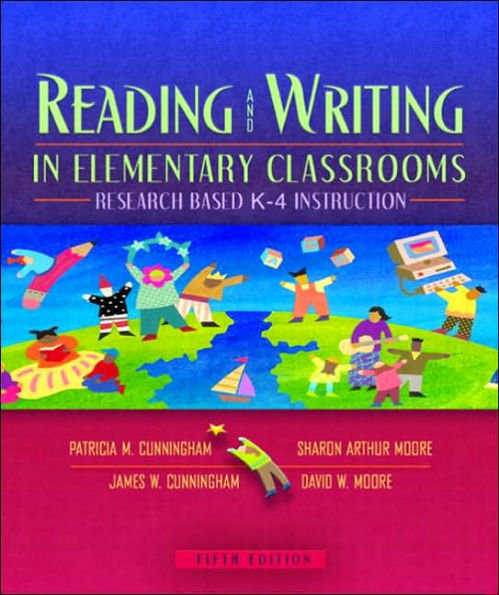Table of Contents
Chapters begin with “Looking Ahead” and conclude with “Looking Back,” “Add To Your Journal,” “Application Activities,” “References,” and “Additional Readings.”
I. In Elementary Classrooms.
1. About Reading and Writing.
Thinking Is the Essence of Reading and Writing.
Feeling Is the Energizer of Reading and Writing.
Language Is the Foundation of Reading and Writing.
There Are Individual, Cultural, and Language Differences Among the Children We Teach.
Reading and Writing Are Learned in a Variety of Ways.
Children Need a Balanced Literacy Program.
2. Emergent Literacy.
Emerging Readers and Writers Develop Seven Crucial Understandings About Print.
Reading to Children Supports Emergent Literacy.
Shared Reading with Predictable Big Books Supports Emergent Literacy.
Accommodations and Adaptations for Phonemic Awareness.
Shared Writing and Language Experience Activities Support Emergent Literacy.
Accommodations and Adaptations Using Language Experience and Shared Writing.
Having Children Write Supports Emergent Literacy.
The Theory and Research Base for Emergent Literacy.
3. Fluency.
Fluency Is a Bridge Between Word Identification and Comprehension.
Accommodations and Adaptations to Teach Sight Words.
Fluency Develops as Children Engage in Various Types of Repeated Readings.
Accommodations and Adaptations for Fluency.
For Inclusion and Children Learning English.
Children Become Fluent Decoders and Spellers When They Do Lots of Reading and Writing Throughout the School Day.
The Theory and Research Base for Fluency Instruction.
4. Phonics and Spelling.
Readers Use Patterns to Decode and Spell New Words.
Beginning Readers Must Develop Phonemic Awareness and Learn Some Letter Names and Sounds.
Accommodations and Adaptations for Phonemic Awareness, Letter Names, and Sounds.
Children Must Develop Strategies for Decoding and Spelling Unknown Words.
Knowledge of Morphemes Is Required for Multisyllabic Words.
The Theory and Research Base for Phonics and Spelling Instruction.
5. Prior Knowledge and Meaning Vocabulary.
Activate Prior Knowledge When Presenting New Ideas.
Introduce Vocabulary in Meaningful Settings.
Select Vocabulary for Special Attention.
Represent Word Meanings Multiple Ways.
Accomodations and Adaptations for Vocabulary.
Develop Independence in Vocabulary Learning.
Accomodations and Adaptations for Morphemic Analysis.
Promote Vocabulary in All Subjects.
The Theory and Research Base For Prior Knowledge Activation and Vocabulary Instruction.
6. Reading and Responding to Literature for Children.
Welcome the Diverse World of Literature.
Use Literature to Promote Thinking and Feeling.
Accommodations and Adaptations—Just the Right Book.
Link Reading and Writing Instruction with Children's Books.
Schedule Daily Self-Selected Reading.
Celebrate Book Response Projects.
Enrich All Subjects with Literature.
The Theory and Research Base.
For Reading and Responding to Literature for Children.
7. Comprehension.
Reading Comprehension Requires Word Identification, Prior Knowledge, Strategies, and Engagement.
Comprehension Can Be Developed with All Kinds of Materials in all Subjects.
Comprehension Strategy Lessons Engage Students Before, During, and After Reading.
Use a Variety of Before and After Reading Activities to Teach Comprehension Strategies.
Accommodations and Adaptations That Develop Comprehension.
Use a Variety of Reading Formats to Make Guided Reading Multilevel.
The Theory and Research Base for Comprehension.
8. Writing.
Self-Selected Writing Promotes Engagement.
Accommodations and Adaptations That Develop Writing.
Students Should Learn to Produce Certain Types of Writing.
Accommodations and Adaptations That Develop Writing.
Reading Can Support Writing and Writing Can Support Reading.
Teach Conventions So That Students Apply Them in Their Own Writing.
Students Should Write in All Subjects.
The Theory and Research Base for Writing Instruction.
9. Assessment.
Be Sure Your Assessment Is Reliable and Valid.
Determine Instructional Reading Levels by Observing How Your Students Read.
Use Daily Observation and Anecdotal Records as the Cornerstone of Your Assessment.
Include Students Attitudes and Interests in Your Assessment.
Create Portfolios to Monitor and Demonstrate Progress.
Beware of Standardized Tests.
The Theory and Research Base for Assessment.
10. Planning and Organizing.
Start Your Year with a Plan.
Use a Varity of Grouping Structures.
Engage Parents as Partners.
Enlist the Help of Others to Meet the Needs of all Your Students.
The Theory and Research Base for Planning, Assessment and Organization.
ADDITIONAL READINGS.
II. In Elementary Classrooms.
This section allows you to follow a fictional class of children through the long-term process of acquiring high levels of literacy, from kindergarten to fourth grade, through the journals of their teachers.
11. Miss Launch: Kindergarten.
12. Mrs. Wright: First Grade.
13. Miss Nouveau: Second Grade.
14. Mrs. Wise: Third Grade.
15. Ms. Maverick: Fourth Grade.



